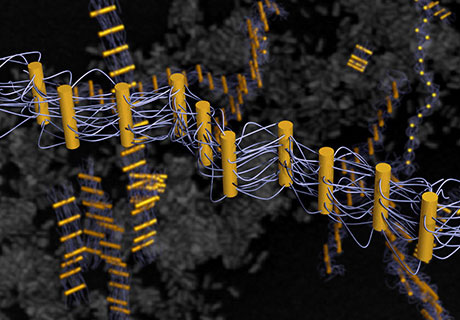- Home
- Facilities
- Research
-
Working at CFN
- Arrival & Departure
- Reports & Publications
- Acknowledging Use of CFN Facilities
- Data Management
- The Guide to Brookhaven
Safety Procedures
- Operations Plan
- Experimental Safety Reviews (ESR)
- COSA Training
- Hours of Operation
- Laser System Qualification
- Transport of Hazardous Materials
- Vendor On-site Scheduling Procedure (PDF)
- News & Events
- People
- Jobs
- Contact
- Business
- Intranet
Five-year Strategic Plan
Strategic Plan Executive Summary
The Center for Functional Nanomaterials (CFN) is a Nanoscale Science Research Center operated for the U.S. Department of Energy (DOE) at Brookhaven National Laboratory (BNL). As a national scientific user facility, the CFN mission is to empower nanoscience research, by providing essential capabilities and technical expertise, achieving breakthrough discoveries through internal research, and swiftly adapting to evolving national research priorities. CFN uniqueness stems from positive synergies among the expert staff, talented facility users, portfolio of distinctive nanoscience instruments, and a core commitment to collaborative research. The CFN drives nanoscience advances through innovative research methodologies and by supporting cutting-edge capabilities to address complex materials challenges with agility. An adaptable model positions the facility to respond effectively to national research priorities as they emerge. The Five-year Strategic Plan is guided by the ethos of acceleration, embodied in three core nanoscience Themes and two Crosscutting elements, which define a unique CFN identity reflecting the technical expertise of the staff and guiding development of new, state-of-the-art facilities.
The subject of Theme One is Nanomaterial Synthesis by Assembly, which envisions design strategies for synthesis of new materials with targeted functionality by assembly of nanoscale components, for rapid explorations of vast landscapes of complex structural motifs. CFN research on self-assembly devises new approaches to interaction- and process-controlled assembly of components, discovers the governing principles underlying self-assembly, and understands assembly pathways using advanced ex situ and in situ characterization and computational methods. Efforts are focused on developing nanomaterial synthesis-by-assembly methods and realizing functional material designs from polymer, nanoparticle, biomolecule-based, and 2D material components. Automation of synthesis-by-assembly processes will provide parallelism and reproducibility, facilitate assembly of increasingly complex architectures, provide control of assembly pathways, and allow incorporation of real-time feedback during processing. Advanced characterization and new methods to probe structure include nanoscale coherent X-ray beams at NSLS-II and 3D imaging of nanostructures by cryo- and in-liquid electron microscopy. Theory and simulation complement the experimental effort, including developing effective self-assembly strategies, assessing the inherent stability of resulting morphologies, and mapping the advantages and limitations imposed by kinetics.
The focus of Theme Two is Accelerated Nanomaterial Discovery, which seeks to implement artificial intelligence and machine learning to streamline the material synthesis-characterizationanalysis loop. While historically the discovery and development of new materials has followed an iterative process of synthesis, measurement, and modeling, suitable integration of advanced characterization, robotics, and machine-learning can potentially radically accelerate this process. The CFN has an established record of discovering nanomaterials by applying new materials synthesis strategies, advanced characterization, and machine-learning. Integrating these efforts will enable autonomous platforms for iteratively exploring material parameter spaces, which have potential to revolutionize materials science by uncovering fundamental links between synthetic pathways, material structure, and functional properties.
CFN scientists are conducting research and developing instruments toward accelerating the material discovery loop. Realizing this vision requires advancing and automating all aspects of the discovery process, including: implementing combinatorial libraries and real-time synthesis platforms; improving multi-modal characterization and analysis of complex datasets; and using machine-learning to drive experiments.
Theme Three emphasizes the study of Nanomaterials in Operando Conditions, which accelerates research by monitoring materials in their operating environments. Interrogating materials at the nanoscale to derive atomic-level information on physicochemical processes under operating conditions remains a forefront and evolving nanoscience research field. The CFN will augment its comprehensive suite of instruments for operando studies of nanomaterials such as catalysts, photocatalysts, and battery electrodes. The CFN will increasingly integrate operando capabilities with data management and computational resources for advanced data analytics.
CFN users, working independently or collaborating with CFN staff, use combinations of in situ and operando capabilities at high temperatures and variable pressures to understand catalytic reaction mechanisms. Aberration-corrected transmission electron microscopy with high spatial and energy resolution illuminates reaction pathways and structural changes in energy storage systems. Scanned-probe microscopy, infrared reflection absorption spectroscopy, and X-ray photoemission spectroscopy provide details of the elementary reaction steps through coordinated studies of model catalyst systems. Computational methods link atomistic structures to specific spectroscopic signatures and with catalytic functionality.
Two Crosscutting elements increasingly span a majority of CFN research and facility activities. The CFN excels in integrating diverse, complementary capabilities for Multimodal Nanoscience investigations, providing a comprehensive toolset to meet the demands of characterizing complex, modern materials. The CFN is also advancing Artificial Intelligence and Machine Learning for Nanoscience, developing accessible and robust tools for data processing, instrument operation, and generation of reliable simulation data.
The CFN Strategic Plan is grounded in foundational Pillars of an expert staff, an engaged user community, and a collection of strategic partners — all working safely and supported by excellent operations and a portfolio of state-of-the-art capabilities. The CFN is working toward higher levels of user engagement and diversity, through strategic partnerships with larger initiatives aligned with national initiatives, technical workshops customized to communities with specialized needs, and by visibly promoting user science accomplishments. During the next five years, the CFN will invest in new instrumentation, make major upgrades to distinctive capabilities, and develop new data-analytics and data-management methods to maintain its status as a cutting-edge user facility. A high priority is continuing to enhance the partnership between CFN and NSLS-II, through: investing further in four partner X-ray nanoscience instruments; working together to identify opportunities to create unique, new capabilities; and advancing joint projects with NSLS-II staff and users that exploit the complementary properties of X-rays and electrons to collect multimodal information on the same samples.







